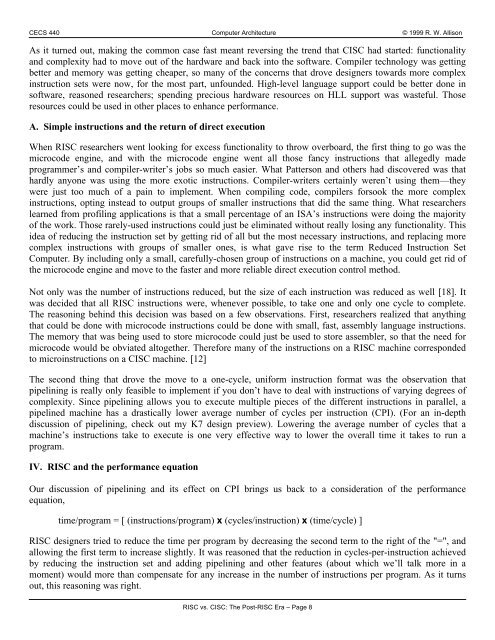RISC vs. CISC
RISC vs. CISC
RISC vs. CISC
Create successful ePaper yourself
Turn your PDF publications into a flip-book with our unique Google optimized e-Paper software.
CECS 440 Computer Architecture © 1999 R. W. Allison<br />
As it turned out, making the common case fast meant reversing the trend that <strong>CISC</strong> had started: functionality<br />
and complexity had to move out of the hardware and back into the software. Compiler technology was getting<br />
better and memory was getting cheaper, so many of the concerns that drove designers towards more complex<br />
instruction sets were now, for the most part, unfounded. High-level language support could be better done in<br />
software, reasoned researchers; spending precious hardware resources on HLL support was wasteful. Those<br />
resources could be used in other places to enhance performance.<br />
A. Simple instructions and the return of direct execution<br />
When <strong>RISC</strong> researchers went looking for excess functionality to throw overboard, the first thing to go was the<br />
microcode engine, and with the microcode engine went all those fancy instructions that allegedly made<br />
programmer’s and compiler-writer’s jobs so much easier. What Patterson and others had discovered was that<br />
hardly anyone was using the more exotic instructions. Compiler-writers certainly weren’t using them—they<br />
were just too much of a pain to implement. When compiling code, compilers forsook the more complex<br />
instructions, opting instead to output groups of smaller instructions that did the same thing. What researchers<br />
learned from profiling applications is that a small percentage of an ISA’s instructions were doing the majority<br />
of the work. Those rarely-used instructions could just be eliminated without really losing any functionality. This<br />
idea of reducing the instruction set by getting rid of all but the most necessary instructions, and replacing more<br />
complex instructions with groups of smaller ones, is what gave rise to the term Reduced Instruction Set<br />
Computer. By including only a small, carefully-chosen group of instructions on a machine, you could get rid of<br />
the microcode engine and move to the faster and more reliable direct execution control method.<br />
Not only was the number of instructions reduced, but the size of each instruction was reduced as well [18]. It<br />
was decided that all <strong>RISC</strong> instructions were, whenever possible, to take one and only one cycle to complete.<br />
The reasoning behind this decision was based on a few observations. First, researchers realized that anything<br />
that could be done with microcode instructions could be done with small, fast, assembly language instructions.<br />
The memory that was being used to store microcode could just be used to store assembler, so that the need for<br />
microcode would be obviated altogether. Therefore many of the instructions on a <strong>RISC</strong> machine corresponded<br />
to microinstructions on a <strong>CISC</strong> machine. [12]<br />
The second thing that drove the move to a one-cycle, uniform instruction format was the observation that<br />
pipelining is really only feasible to implement if you don’t have to deal with instructions of varying degrees of<br />
complexity. Since pipelining allows you to execute multiple pieces of the different instructions in parallel, a<br />
pipelined machine has a drastically lower average number of cycles per instruction (CPI). (For an in-depth<br />
discussion of pipelining, check out my K7 design preview). Lowering the average number of cycles that a<br />
machine’s instructions take to execute is one very effective way to lower the overall time it takes to run a<br />
program.<br />
IV. <strong>RISC</strong> and the performance equation<br />
Our discussion of pipelining and its effect on CPI brings us back to a consideration of the performance<br />
equation,<br />
time/program = [ (instructions/program) x (cycles/instruction) x (time/cycle) ]<br />
<strong>RISC</strong> designers tried to reduce the time per program by decreasing the second term to the right of the "=", and<br />
allowing the first term to increase slightly. It was reasoned that the reduction in cycles-per-instruction achieved<br />
by reducing the instruction set and adding pipelining and other features (about which we’ll talk more in a<br />
moment) would more than compensate for any increase in the number of instructions per program. As it turns<br />
out, this reasoning was right.<br />
<strong>RISC</strong> <strong>vs</strong>. <strong>CISC</strong>: The Post-<strong>RISC</strong> Era – Page 8











